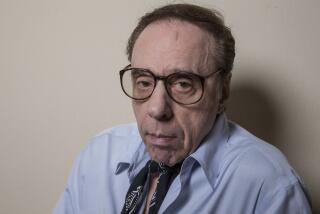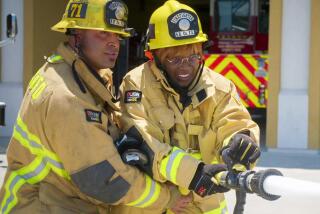TV REVIEW : ‘Year 2000’ Gives Public TV a New Direction
- Share via
The city’s best and freshest local series in years arrives at 7:30 tonight on KCET Channel 28.
It’s “By the Year 2000,” the station’s new weekly half-hour program weighing the impact of important issues on Southern California in the coming decade. The series opens with a well-designed, well-executed, info-laden, highly watchable report on the “greenhouse effect.” That’s the worrisome gradual warming trend that we seem to have caused ourselves by the way we utilize energy sources and release various gases into the environment.
You have to applaud Channel 28’s release of “By the Year 2000” into the television environment, however. Local TV could stand some warming.
The third and fourth programs--on euthanasia (July 26) and drug addiction treatment (Aug. 2) respectively--were also provided for review, and they’re very good. Strongest of three programs, however, is the premiere (produced by Valerie Zavala), which manages to probe a complex problem in a highly understandable manner--with bright graphics and lively reporting and interviewing--without trivializing it.
Foremost among the assets of “By the Year 2000” are talented co-hosts Zavala and Eric Burns. Although generally opening and closing each half hour together, they have a decided division of responsibility in these initial programs: Zavala capably handles the in-field reporting and Burns--whose last local stop was as an Emmy-winning media critic for KTTV Channel 11--handles the in-studio interviewing.
Does he ever. Possessing that rare combination of aggression and a capacity to listen to his subjects and process their information speedily, Burns uses little time in establishing himself as the most incisive interviewer on Los Angeles TV. Although that’s the equivalent of calling someone the best-looking guy in a leper colony, there’s no denying Burns’ skills.
The interviews at times evolve into spirited debates--tonight between USC professor Larry Berg in Los Angeles and “greenhouse effect” skeptic Patrick Michaels from Virginia via satellite--that radiate vitality without becoming mean-spirited. It helps also that no clunkers are included among the early interview subjects.
“By the Year 2000” occasionally slips into the dark abyss of talking heads. But that’s tolerable in such an uncommon setting, one allowing people to express themselves fully.
The emergence of “By the Year 2000” comes at an especially interesting time. The 1980s have seen the Federal Communications Commission steadily deregulate TV, requiring little of the public-service commitment once demanded of broadcasters at license renewal time. With the exception of newscasts, therefore, there is a dearth of responsible, meaningful local programs on commercial stations.
This is where public TV can rush in.
With programs that once made PBS so distinctive--from quality dramas to nature shows--now increasingly available on cable and elsewhere, public TV is finding itself merely one of many alternatives instead of the alternative. The result may be shrinkage of its already tenuous funding.
A new direction is called for, and perhaps that direction is localism--more and more programs tailored to important local needs--the big void that no one else seems willing to address. That’s why “By the Year 2000” is so important.
In Los Angeles, the void fills.
More to Read
The complete guide to home viewing
Get Screen Gab for everything about the TV shows and streaming movies everyone’s talking about.
You may occasionally receive promotional content from the Los Angeles Times.






